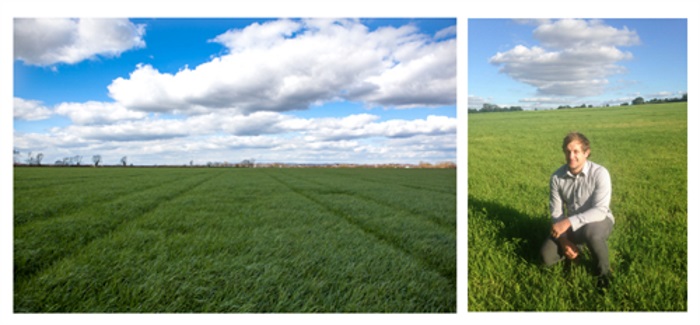Livestock farmers wanting to get more from their grass this summer should be walking their fields at least once a week during spring to monitor pasture quality – that’s the advice from Barenbrug UK, a leading developer of specialist grass seed for the agricultural sector. Armed with information gathered on their weekly walks, farmers will find it easier to finalise their grassland management plans for the year ahead; work out when to turn animals out; and determine grazing rotation patterns.
Commenting, Latham Gibbins, Regional Sales Manager at Barenbrug, said: “As the spring flush gathers momentum, and as grass cover builds, it can become difficult to keep an eye on quality – which can hamper any decision making left to the last minute. That’s why we are advising farmers to head out into the fields now. As a general rule, it’s good practice to walk your fields weekly from February to October to look at grass growth. But this is particularly important at the start of the season, where there is a relatively small window to influence pasture quality.
“In spring you need to look at your grass regularly to see how it’s growing and work out if any remedial work is required. You also need to keep a really close eye on leaf emergence rates as the weather warms up. What you see should dictate turn out times and decisions about grazing rotation length. Graze too early or too late, or get your grazing pressure wrong, and you run the risk of damaging your sward and suffering set backs with yields and nutritional quality later in the year.”
Knowing when to graze grass and for how long requires careful judgment. Barenbrug advises farmers to conduct regular visual checks of the number of tillers present on their grass plants to avoid problems. A ryegrass tiller will maintain up to three live leaves at anyone time:
The first leaf is the smallest and contributes approximately 25% of total growth
The second leaf contributes another 35%
While the third leaf is the biggest and makes up the remaining 40% of total growth
Once a fourth leaf starts to grow, the first leaf will begin to die off.
To maximise plant growth, grass quality, palatability and persistency, farmers should aim to graze between the second and third leaf stage, or earlier if canopy closure has occurred. However, when to graze grass and for how long will depend on the varieties or mixture used.
Graze too early, particularly on a new ley, and you can reduce grass growth and damage sward persistency; a plant’s reserves need time to restore themselves following growth.
Graze too late and the plant will enter the ceiling phase of grass growth. At this stage, tillers continue to produce new leaves, however, there is no further increase in net mass due to the dying off of older leaves. If the sward isn’t grazed at this point, dead material – with little feed value – will build up in the sward base. This in turn will affect the metabolized energy (ME) value of the sward; increase the risk of diseases such as crown rust; and decrease overall grass utilisation.
Concluding, Latham said: “Once you’ve decided when to graze and for how long, don’t get complacent. Walk your fields at least once a week throughout the season. Swards conditions can change quickly depending on the weather and you may need to alter your plans and adjust your grazing pressure accordingly.”
If grazing pressure becomes too high, the result will be a short, stubbly sward, which will ultimately affect animal performance. With short grass, cattle are forced to consume all portions of the sward including poorer quality forage. This can lead to low animal intake and subsequently, low gains. Periods of excessively high grazing pressure can result in a decrease in overall sward production and can even put a field back into the lag phase – where regrowth is slow due to the plant’s sole reliance on its carbohydrate reserves.
If grazing pressure is too low, animal gains per head per day will typically be higher but production levels per acre will be poor. Put simply, low grazing pressure is likely to result in wasted forage. As with prolonged periods of high grazing pressure, extended phases of low grazing pressure can damage a sward, causing a loss of legumes from the stand.
To gauge grass quality and plan the best approach to grassland management, farmers have several tools at their disposal. One of the most common techniques is to make a visual assessment of the field in question. Other options include plate meters or sward sticks, which can be obtained from most major grass seed developers. When scrutinising sward quality, farmers should also routinely check for signs of compaction; measure pH levels; and look at the availability of essential nutrients.


